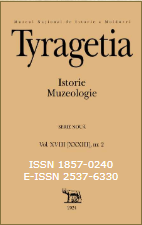Chipul mântuitorului în colecția de icoane a muzeului național de istorie a Moldovei. Tipologii iconografice
Image of the Savior in the icon collection of the National Museum of History of Moldova: Iconographic typology
Author(s): Adelaida ChiroșcaSubject(s): Museology & Heritage Studies, History of Church(es), Visual Arts, History of Religion, History of Art
Published by: Muzeul Naţional de Istorie a Moldovei
Keywords: Jesus Christ the Savior; holdings of the National Museum of History of Moldova; collection of icons; iconographic compositions; gospel image; image of Christ in glory; image not made by human hand;
Summary/Abstract: The collections of the National Museum of History of Moldova contain more than five hundred icons, of which about a hundred depict the image of Jesus Christ. This collection of icons contains a diversity of iconographic models, which necessitated its classification into general types, and then into categories. Most of the compositions represent the stages of the Savior’s earthly life: “Nativity of Christ”, “The Holy Encounter”, and “The Baptism of Jesus”. The preaching period of Christ’s life is reflected in the icons “Jesus and the Twelve Disciples”, “Blessing the Children” and “The Entry of Jesus into Jerusalem”. The Savior’s arrival in Jerusalem actually marked the beginning of the Passion of Christ, a great drama that was preceded by several important events reflected in the scenes of the Last Supper and Prayer in the Garden of Gethsemane. Episodes of detention and trial are reproduced in the icons “Christ in Prison”, “Christ at Pilate’s Court”, “Christ Wearing the Crown of Thorns” and “Carrying the Cross”. The compositions “Crucifixion of Jesus Christ” and the shroud “Entombment” complete this chapter. The image of Christ in glory is reflected in three iconographic compositions: “Transfiguration”, “Resurrection of Jesus Christ” and “Ascension of Jesus Christ”. The creation of these iconographic types, designed to depict events that represent an incomprehensible mystery for a common man, was an extremely difficult task for the clergy and icon painters, who were able to develop a pictorial formula that made it possible to reveal the spiritual greatness of Christ in glory. The image of the Savior not made by human hand includes the icons “The Mandylion of King Abgar” and “The Veil of Veronica”; these are acheiropoieta, the miraculously created images of Jesus Christ. The symbolic image of the Savior is rendered in two museum icons known as the “Good Shepherd”, the most appropriate representation to depict Christ in his immense love for people. The liturgical image of the Lord can be found in the iconographic types “Jesus Christ the True Vine”, “Jesus Christ Pantocrator”, “Jesus Christ the King of Kings” and “Jesus Christ the High Priest”. The collection under consideration is distinguished by a diversity of painting techniques, materials and forms of realization of works, of categories and styles of interpretation – all this gives it authenticity and individuality. Created between the mid-19th and early 20th centuries, these works retain the iconographic features characteristic of that time.
Journal: Tyragetia (Serie Nouă)
- Issue Year: XVIII/2024
- Issue No: 2
- Page Range: 335-347
- Page Count: 13
- Language: Romanian

